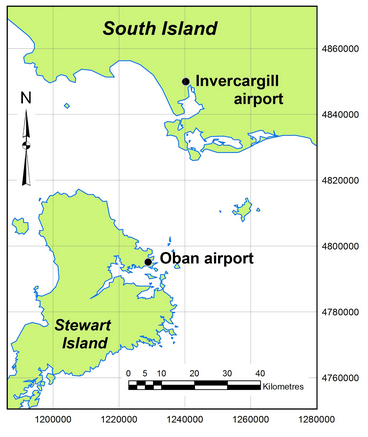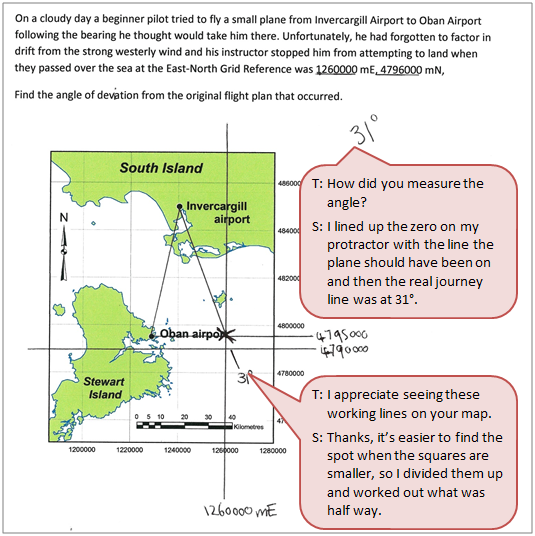The purpose of this activity is to engage students in finding locations from descriptions given and using these to solve a problem.
This activity assumes the students have experience in the following areas:
- Measuring angles with a protractor or compass.
- Using a grid reference on a map to find a location.
- Using cardinal directions (N, E, S, W) on a map to specify a position.
The problem is sufficiently open ended to allow the students freedom of choice in their approach. It may be scaffolded with guidance that leads to a solution, and/or the students might be given the opportunity to solve the problem independently.
The example responses at the end of the resource give an indication of the kind of response to expect from students who approach the problem in particular ways.

It was a cloudy day.
A learner pilot took a training flight in a small plane from Invercargill Airport to Oban Airport.
He followed the bearing he calculated before take-off.
Unfortunately, the learner pilot had forgotten to factor in drift from the strong Westerly wind. The instructor stopped him from landing as they passed over the sea.
Their East-North Grid Reference was:
1260000 mE, 4796000 mN.
Find the angle of deviation from the original flight plan that occurred.
The following prompts illustrate how this activity can be structured around the phases of the Mathematics Investigation Cycle.
Make sense
Introduce the problem. Allow students time to read it and discuss in pairs or small groups.
- Do I understand the situation and the words? (Students may need support to understand the meaning of some terms, such as bearing, grid reference, and drift.)
- Where else in my life/the world can I see this happen? (Student may have used the cardinal directions and grid references on maps before.)
- Can I draw or sketch the flight path on the map? How?
- What will my solution look like? (The solution will be the angle between the expected flight path and the wind-altered path.)
Plan approach
Discuss ideas about how to solve the problem. Emphasise that, in the planning phase, you want students to say how they would solve the problem, not to actually solve it.
- What strategies can I use to get started? What are my first steps?
- Do I have an estimation of the wind-altered path? How much do I expect the plane to be blown off course?
- How will I find where the plane is when the instructor stops the landing?
- What tools (digital or physical) could help my investigation? (A compass or protractor will be useful, as will a straight edge.)
Take action
Allow students time to work through their strategy and find a solution to the problem.
- Have I been systematic in using all the information?
- Have I left anything out?
- Is my recording useful in managing my memory load and showing others how I found my answer?
- Does my answer seem correct? Does it answer the question? Is it close to my estimation?
- Is there another possible answer or way to solve the problem?
Convince yourself and others
Allow students time to check their answers and then either have them pair share with other groups or ask for volunteers to share their solution with the class.
- Is my working clear for someone else to follow?
- Have I checked for possible errors?
- How would I convince someone else I am correct?
- Would my strategies work in a different situation? Could I apply my thinking to other tasks that involve grid references and bearings (angles)?
Examples of work
Work sample 1
The student calculates, with guidance, values in standard form, giving an answer to an appropriate degree of accuracy.
Click on the image to enlarge it. Click again to close.
Work sample 2
The student calculates values in standard form, giving an answer to an appropriate degree of accuracy. The student incorporates wider aspects of the context to make a valued judgement.

